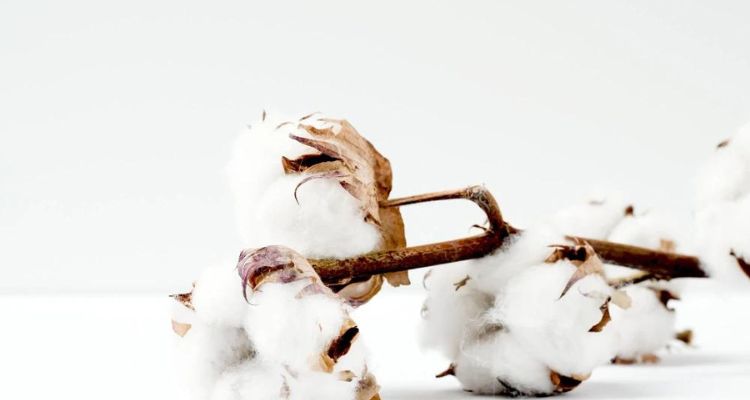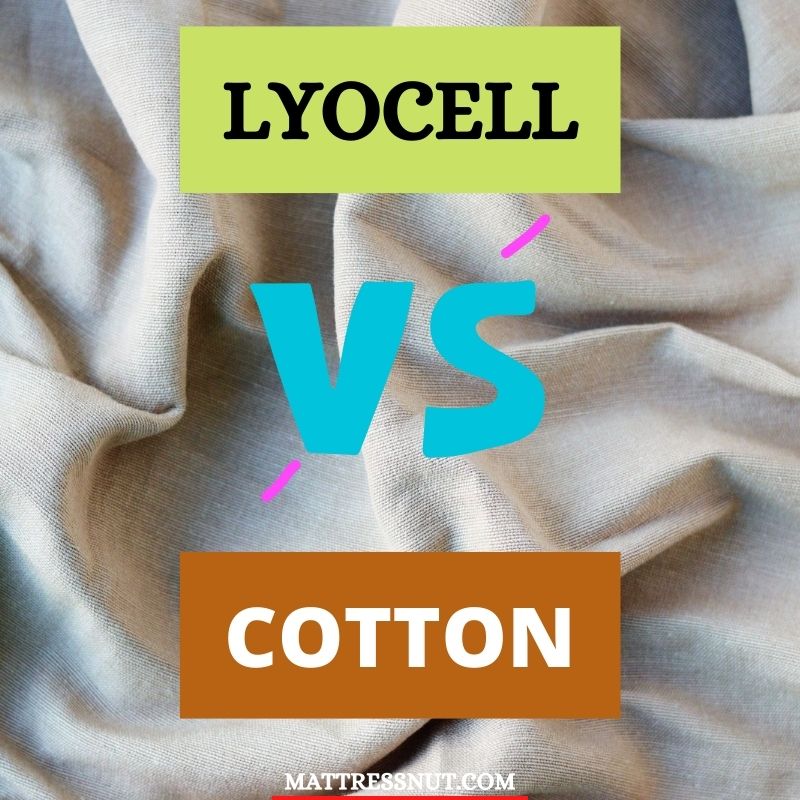Bed sheets are available in different fabric types, and choosing the best one can be a tough task. You can find polyester, rayon, cotton, lyocell, nylon, wool, and some blends as well.
Lyocell and cotton are two of the strongest competitors as they come with different features suitable for other sleepers. Moreover, they are available in different types and have many benefits.
So, let’s begin with our comprehensive comparison and see which of these two is suitable for whom.
What’s a Cotton Fabric?
This fabric is one of the oldest and most widely available globally. This is because cotton plants produce those fibrous seed pods already made of threads.

These threads form a tight ball around the seed and protect it during development. These threads help in dispersing the seed for plant propagation.
With this type of reproductive cycle, cotton is among the easiest plants for fabric processing. It’s all about pulling the seed out, washing the fibers, and detangling them, and it’s ready to spin into threads.
Due to this, cotton has been widely used across the globe, and that too from ancient times. The best part is you don’t have to go for additives.
Cotton types
There are so many different types of cotton, and they have to be classified into two major categories based on the lengths of the fibers.
Long staple
Long staple cotton is expensive but offers better quality and high durability. Moreover, it has a luxurious feel and includes the likes of Pima cotton and Egyptian cotton.
Short staple
This type is much easier and quicker to grow and process. It is also much simpler to weave as compared to long-staple cotton. Therefore, it is a low-cost alternative to its long-staple counterpart and is cheaper in quality.
Benefits of Cotton
There are various benefits that cotton has to offer. And these are;
- It is much more budget-friendly.
- Cotton is extraordinarily durable, especially in the long run.
- It gets softer with every wash.
- Cotton sheets are very easy to maintain, and you can wash them whenever possible.
Drawbacks of cotton
Here are some drawbacks that cotton sheets have;
- The different types available of this fabric are so confusing and overwhelming.
- Cotton does tend to wrinkle.
- Cotton sheets are not environmentally friendly (excluding organic options).
What’s a Lyocell Fabric?
This fabric is a kind of rayon that is developed from cellulose fiber. This cellulose fiber is developed when the wood pulp is dissolved within a solvent to create a liquid.
This fluid is then forced through minuscule holes to make strands that can be woven into a fabric. Lyocell is an enhancement on viscose, and it can be turned into anything else, ranging from eco-friendly sheets and clothing to sustainable denim.
Lyocell has been around for a few decades, as it was invented in the 1970s by American Enka. On the other hand, cotton has been around for centuries. But lyocell quickly gained momentum as it was a suitable alternative to synthetic and animal-based fabrics, such as silk.
Lyocell fabric types
If you look around for lyocell fabric, you will quickly stumble upon TENCEL, which is one major category of this fabric, while all other lyocell materials are categorized separately.
TENCEL
It’s a brand of lyocell fabric that Courtaulds Fibers UK developed. This fabric type is developed from eucalyptus wood sourced sustainably and spun from indifferent fibers within a closed-loop mechanism. It means any chemicals used in the development processes are not dumped and rescued in the entire process.
Other lyocell materials
In most cases, lyocell is developed from eucalyptus wood, and some other trees are used in this process, including birch and oaks wood.
Bamboo lyocell is available, and as it has hard pulp, quick-growing grass is utilized to spin fibers for weaving bamboo sheets. But these materials might or might not be sourced from sustainable forests. This is not the case with TENCEL.
Benefits of lyocell fabric
Here are some benefits that lyocell has to offer;
- It’s a naturally cooling fabric, making it an ideal choice for hot sleepers.
- This fabric is developed using a closed-loop process; no waste is dumped, so it is eco-friendly.
- Lyocell is a better option for all those sensitive skin types as it is hypoallergenic (check the top rated bed sheets for allergies).
- It is less prone to wrinkles.
Drawbacks of lyocell fabric
However, there are some drawbacks associated with lyocell, which are;
- Lyocell is pretty expensive due to its environmentally-friendly production process.
- You must be more careful when cleaning lyocell sheets as you can only wash them in a delicate cycle using a delicate detergent.
Difference between Lyocell vs. Cotton
Let’s dive into more details and find out how lyocell and cotton are different from one another;
Durability – Cotton has a definite advantage over lyocell
Cotton tends to become softer and more durable over time with every wash. Cotton is a good choice in the long run because these sheets will last long.
On the other hand, lyocell has to be properly maintained because it is more delicate than cotton. So, you have to be more careful when handling this fabric. It tends to wear out and rip pretty fast.
Feel – Lyocell has a definite edge over cotton
Lyocell tends to feel much softer and smoother than cotton from day one. At the same time, cotton gets softer with every wash. But overall, cotton has a much creeper appearance than lyocell. So, lyocell would be your go-to option if you want a comfortable feel (check the most comfy bed sheets).

Cost – Cotton is the obvious choice
Cotton is a clear winner over lyocell because even the more experienced types of cotton, such as Egyptian cotton, won’t cost you as much as the lyocell alternatives available on the market. So, if you are tight on the budget, you need to consider going for cotton sheets.
Maintenance – This one will be a tie
Again, cotton will be ahead of lyocell in this department because you don’t have to worry about the cleaning cycle of your washing machine. You can throw your sheets in your washer and use any detergent.
The same can’t be said for lyocell because it’s much more delicate than cotton, and you can only wash it with a delicate cycle using mild detergent. But lyocell is better when it comes to piling and wrinkles. This is because cotton is more prone to wrinkles and piling, especially the shorts-staple type.
Sustainability – Lyocell is a clear winner
This round goes to lyocell because cotton needs a lot of irrigation and fertilizer. You will need plenty of pesticides during the irrigation process. This plant is not great for use as it ruins soil and requires plenty of field rotation.
On the other hand, lyocell is developed from sustainable crops, and no chemicals are dumped into the environment because they are rescued in the development process.
Temperature regulation – This one will tie
This one will tie in between cotton and lyocell because they offer excellent temperature moderation. These breathable fabrics can divert body heat.
Hypoallergenic – This one will tie
Both cotton and lyocell are hypoallergenic. They both feel softer and are great for sensitive skin types. There are different varieties available for sensitive skin types too.
Comparison Table – Lyocell vs Cotton
| Lyocell | Cotton | |
| Durability | Slightly less durable | Far more durable |
| Feel | Softer feel right from day one | It gets softer with every wash |
| Cost | Much more expensive due to the sustainable production process | Less costly as the production process is much simpler |
| Maintenance | Careful maintenance is a must because the fabric is prone to rips and tears | Not much care is needed because cotton is a pretty sturdy material |
| Sustainability | Highly sustainable due to its production process | No |
| Temperature regulation | Excellent temperature regulation and moisture wicking | Excellent temperature regulation and high breathability |
| Hypoallergenic | Top choice for sensitive skin types | Excellent for sensitive skin types. |
Who Should Use Cotton Fabric Bedding?
Cotton is highly preferable for anyone who is looking for a durable fabric, and it doesn’t require much maintenance. Though cotton does tend to pile and wrinkle, going for long-staple types is a better choice because they feel more luxurious, and you won’t have to break your wallet to get them.
Cotton fabric bedding is an excellent choice for:
- Those who prefer to sleep on highly breathable sheets that feel soft underneath.
- People who have sensitive skin types have to deal with different allergies or asthma.
- Those looking for a less expensive and highly durable fabric offer exceptional value for money.
- Cotton is an excellent choice for anyone who wants to sift through various options.
Who Should Use Lyocell Fabric Bedding?
Of course, lyocell is much more expensive than cotton. But if your budget allows it, and you don’t have any trouble dealing with a slightly more delicate fabric, then going for lyocell is a good choice.
Lyocell is a better option for those;
- People who prefer to sleep on a soft sheet right from day one. You won’t have to wait a few washes to make your sheet feel softer.
- Those people tend to sleep hot and deal with night sweats. Lyocell is not only breathable but is also moisture-wicking.
- People who don’t want to be overwhelmed by so many types of fabric to choose from.
Key Takeaways: Lyocell Vs Cotton
Understanding Cotton Fabric
Cotton is one of the oldest and most widely available fabrics globally, known for its ease of processing. It is available in various types, including long-staple and short-staple, each with its benefits and drawbacks.
Benefits of Cotton
Cotton is budget-friendly, exceptionally durable in the long run, and becomes softer with each wash. It’s easy to maintain, but it can be confusing due to the variety of types available. However, cotton tends to wrinkle and may not be environmentally friendly.
Understanding Lyocell Fabric
Lyocell is a type of rayon developed from cellulose fiber, primarily sourced from wood pulp. It is known for its eco-friendly production process, especially in the case of TENCEL. Lyocell offers benefits like natural cooling, hypoallergenic properties, and resistance to wrinkles.
Benefits of Lyocell Fabric
Lyocell is naturally cooling and eco-friendly, making it suitable for hot sleepers and environmentally conscious individuals. It is also hypoallergenic and less prone to wrinkles, providing a comfortable feel.
Difference Between Lyocell and Cotton
Lyocell tends to be less durable than cotton but feels softer from the beginning. Cotton becomes more durable over time with each wash. Cotton is more cost-effective, while lyocell is pricier due to its eco-friendly production process. Cotton is easier to maintain, whereas lyocell requires delicate care. Lyocell is more sustainable due to its production process. Both fabrics offer excellent temperature regulation and are hypoallergenic.
Who Should Use Cotton Fabric Bedding?
Cotton bedding is suitable for those seeking durability, breathability, and ease of maintenance. Long-staple cotton types provide a luxurious feel and value for money. It is an excellent choice for sensitive skin and budget-conscious individuals.
Who Should Use Lyocell Fabric Bedding?
Lyocell bedding is a good choice for those willing to invest in a more expensive but eco-friendly option. It offers immediate softness and is ideal for hot sleepers and individuals with sensitive skin. Lyocell simplifies fabric selection for those overwhelmed by choices.
Conclusion:
Lyocell and cotton are two of the most special types of fabrics that you can use for bedding. However, both materials have pros and cons and are suitable in different scenarios.
Cotton is more budget-friendly, breathable, and durable, while lyocell is expensive, delicate, breathable, and moisture-wicking.
Lyocell is an excellent option for hot sleepers dealing with night sweats. Cotton is a much better option overall due to its low cost and low maintenance. But lyocell is sustainable and environmentally friendly too.
Cotton is better suitable for general use, while lyocell is more specialized and targeted towards hot sleepers. Cotton is superior in terms of value for money and ease of use. So, which one are you going to go for?
Lyocell vs Cotton FAQs
Is lyocell as durable as cotton?
Cotton is far more durable than lyocell, and different varieties are available. With every wash, cotton becomes increasingly stable, and you have to be very careful with the lyocell and how you wash it.
Is lyocell better than polyester?
Polyester isn’t as breathable as lyocell and isn’t as effective in moisture-wicking either. Lyocell might be more delicate than polyester, so you must take care of it. So, it all comes down to your preferences and how you handle different fabric types.
Does lyocell feel like cotton?
Yes, lyocell is extremely comfortable and highly gentle on your skin. Lyocell is as soft as silk or cotton.
Is lyocell a cheap fabric?
No, lyocell is not a cheap fabric because its production process is highly sustainable and environmentally friendly.
Does lyocell shrink or wrinkle?
Lyocell can wrinkle, but in general, it resists wrinkles. You can iron out any wrinkles pretty conveniently. But you must be careful here because this fabric can shrink dramatically when exposed to high temperatures. Therefore, use a gentle setting for ironing your lyocell sheets.

